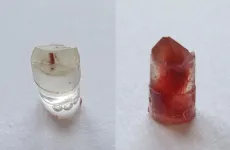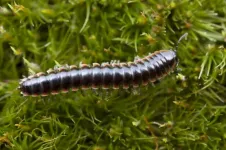The exoplanet-hunting instrument MAROON-X has obtained its first scientific result from its new home at the 8.1-meter Gemini North telescope, part of the international Gemini Observatory, a program of NSF's NOIRLab [1]. Shipped from the University of Chicago in mid-2019, the instrument arrived at Gemini in a collection of wooden packing crates. Despite exhausting 12-hour shifts in the thin air at an altitude of 4300 meters (14,000 feet), the MAROON-X team successfully constructed and installed the instrument in a six-month process known as commissioning. The assembled instrument takes advantage of Gemini North's location on Maunakea in Hawai'i -- one of the best observing sites on the planet.
"It's been an intense six-month stretch," explained Jacob Bean, head of the University of Chicago team behind MAROON-X. "We've spent ten years developing the instrument and with MAROON-X now installed on Gemini we will start to get real insights into habitable worlds around other stars."
The technical core of MAROON-X lies at the end of a bundle of fibers trailing from behind the main mirror of Gemini North to a small room several floors below. Inside this temperature-controlled room and encased in a vacuum chamber, a collection of high-precision optical devices forms the spectrometer at the heart of MAROON-X. This spectrometer measures variations in the light from distant stars to detect the subtle influence of orbiting worlds -- making MAROON-X an outstanding exoplanet hunter [2].
MAROON-X's first science result determined the mass of the newly discovered rocky planet Gliese 486 b, which orbits Gliese 486, a star smaller and dimmer than our own Sun [3]. The planet has a mass roughly three times that of the Earth, but has a similar density. The composition of this newly discovered exoplanet is not its only distinguishing feature -- its relative closeness to Earth makes it an ideal candidate for observations with the next generation of astronomical technology.
"The proximity of this exoplanet is exciting because it will be possible to study it in more detail with powerful telescopes such as the upcoming James Webb Space Telescope and the various Extremely Large Telescopes such as the GMT and TMT," explained Trifon Trifonov, lead author of the paper reporting this discovery. "Within the next few years, we hope to use transit spectroscopy to search for signs of an atmosphere and possibly determine this planet's surface composition."
MAROON-X was developed to find and characterize exactly this type of exoplanet -- rocky worlds around nearby stars whose atmospheres are suitable for follow-up investigation using future instruments. As well as next-generation telescopes, MAROON-X was designed to work alongside NASA's Transiting Exoplanet Survey Satellite (TESS). In the case of Gliese 486 b, the team used MAROON-X measurements and additional data from the CARMENES [4] spectrograph at the Calar Alto Observatory to determine the exoplanet's mass, and combined this with the planetary radius measured by the TESS mission to find the density of Gliese 486 b -- revealing it to be a rocky super-Earth.
"MAROON-X provides a new, valuable addition to Gemini's visiting instrument program. Demonstrating exciting precision and sensitivity, it is available for use by the astronomical community to discover and characterize new worlds," said National Science Foundation Division of Astronomical Sciences Program Officer Martin Still.
MAROON-X's capabilities are already popular amongst the astronomical community, with a surge of requests for observation time following the instrument's commissioning. Four long observation campaigns have already been completed despite the impact of COVID-19, as MAROON-X can be operated fully remotely. In fact, the observations of Gliese 486 b were some of the first observations obtained with Gemini North after it restarted operations in May 2020. Even without astronomers on site, the capabilities of Gemini and MAROON-X have been impressive -- the instrument can detect exoplanets around stars that are 150 times fainter than those visible to the naked eye.
"This result demonstrates the unprecedented capability of MAROON-X," concluded Jacob Bean. "This is only our first result, and as we find more we will determine what kinds of rocky planets are out there, ultimately helping us learn more about the formation and evolution of the Earth."
INFORMATION:
Notes
[1] MAROON-X is a visitor instrument at Gemini North. The Gemini Visiting Instrument program allows the observatory to respond to the emerging needs of the astronomical community by hosting instruments developed by astronomers themselves. This program gives astronomers the opportunity to use specialized instruments for their scientific needs while sharing a diverse range of instruments with the wider astronomical community.
[2] Astronomers can measure the mass of an exoplanet by observing its host star, as the vast majority of exoplanets cannot be directly imaged. Instead, astronomers measure the tiny movements of host stars as they are tugged back and forth by the gravitational attraction of an orbiting planet; the more massive the exoplanet, the more the host star will be tugged to and fro. MAROON-X measures this stellar motion by capturing incredibly precise shifts in the star's spectrum.
[3] The convention for naming exoplanets is to take the name of the parent star and add a lower case letter as a suffix, starting with the letter b. As this exoplanet is the first to be discovered orbiting the star Gliese 486, it takes the name Gliese 486 b.
[4] CARMENES is the Calar Alto high-Resolution search for M dwarfs with Exoearths with optical and Near-infrared Echelle spectrographs.
More information
This research was published in the paper A nearby transiting rocky planet ideal for atmospheric investigation to appear in the journal Science.
The team was composed of T. Trifonov (Max-Planck-Institut für Astronomie), J. A. Caballero (Centro de Astrobiología), J. C. Morales (Institut de Ciències de l'Espai and Institut d'Estudis Espacials de Catalunya), A. Seifahrt (The University of Chicago), I. Ribas (Institut de Ciències de l'Espai and Institut d'Estudis Espacials de Catalunya), A. Reiners (Institut für Astrophysik, Georg-August-Universität), J. L. Bean (The University of Chicago), R. Luque (Instituto de Astrofísica de Canarias and Universidad de La Laguna), H. Parviainen (Instituto de Astrofísica de Canarias and Universidad de La Laguna), E. Pallé (Instituto de Astrofísica de Canarias and Universidad de La Laguna), S. Stock (Zentrum für Astronomie der Universität Heidelberg) , M. Zechmeister (The University of Chicago), P. J. Amado (Instituto de Astrofísica de Andalucía), G. Anglada-Escudé (Institut de Ciències de l'Espai and Institut d'Estudis Espacials de Catalunya), M. Azzaro (Centro Astronómico Hispano-Alemán), T. Barclay (NASA Goddard Space Flight Center, and University of Maryland), V. J. S. Béjar (Instituto de Astrofísica de Canarias and Universidad de La Laguna), P. Bluhm (Zentrum für Astronomie der Universität Heidelberg), N. Casasayas-Barris (Instituto de Astrofísica de Canarias and Universidad de La Laguna), C. Cifuentes (Centro de Astrobiología), K. A. Collins (Center for Astrophysics | Harvard & Smithsonian), K. I. Collins (George Mason University), M. Cortés-Contreras (Centro de Astrobiología), J. de Leon (The University of Tokyo), S. Dreizler (Institut für Astrophysik, Georg-August-Universität), C. D. Dressing (University of California at Berkeley), E. Esparza-Borges (Instituto de Astrofísica de Canarias and Universidad de La Laguna), N. Espinoza (Space Telescope Science Institute), M. Fausnaugh (Massachusetts Institute of Technology), A. Fukui (The University of Tokyo), A. P. Hatzes (Thüringer Landessternwarte Tautenburg), C. Hellier (Keele University), Th. Henning (Max-Planck-Institut für Astronomie), C. E. Henze (NASA Ames Research Center), E. Herrero (Institut de Ciències de l'Espai and Institut d'Estudis Espacials de Catalunya), S. V. Jeffers (Institut für Astrophysik, Georg-August-Universität), J. M. Jenkins (NASA Ames Research Center), E. L. N. Jensen (Swarthmore College), A. Kaminski (Zentrum für Astronomie der Universität Heidelberg), D. Kasper (The University of Chicago), D. Kossakowski (Max-Planck-Institut für Astronomie), M. Kürster (Max-Planck-Institut für Astronomie), M.Lafarga (Institut de Ciències de l'Espai and Institut d'Estudis Espacials de Catalunya), D. W. Latham (Center for Astrophysics | Harvard & Smithsonian), A. W. Mann (University of North Carolina at Chapel Hill,), K. Molaverdikhani (Zentrum für Astronomie der Universität Heidelberg), D. Montes (Departamento de Física de la Tierra y Astrofísica & IPARCOS-UCM), B. T. Montet (University of New South Wales), F. Murgas (Instituto de Astrofísica de Canarias and Departamento de Astrofísica, Universidad de La Laguna), N. Narita (The University of Tokyo, Japan Science and Technology Agency, Astrobiology Center, and Instituto de Astrofísica de Canarias), M. Oshagh (Instituto de Astrofísica de Canarias and Universidad de La Laguna), V. M. Passegger (Universität Hamburg and University of Oklahoma,), D. Pollacco (University of Warwick), S. N. Quinn (Center for Astrophysics | Harvard & Smithsonian), A. Quirrenbach (Zentrum für Astronomie der Universität Heidelberg), G. R. Ricker (Massachusetts Institute of Technology), C. Rodríguez López (Instituto de Astrofísica de Andalucía), J. Sanz-Forcada (Centro de Astrobiología), R. P. Schwarz (Patashnick Voorheesville Observatory), A. Schweitzer (Universität Hamburg), S. Seager (Massachusetts Institute of Technology), A. Shporer (Massachusetts Institute of Technology), M. Stangret (Instituto de Astrofísica de Canarias and Universidad de La Laguna), J. Stürmer (Universität Heidelberg), T. G. Tan (Massachusetts Institute of Technology), P. Tenenbaum (Massachusetts Institute of Technology), J. D. Twicken (SETI Institute and NASA Ames Research), R. Vanderspek (Massachusetts Institute of Technology), and J. N. Winn (Princeton University).
NSF's NOIRLab (National Optical-Infrared Astronomy Research Laboratory), the US center for ground-based optical-infrared astronomy, operates the international Gemini Observatory (a facility of NSF, NRC-Canada, ANID-Chile, MCTIC-Brazil, MINCyT-Argentina, and KASI-Republic of Korea), Kitt Peak National Observatory (KPNO), Cerro Tololo Inter-American Observatory (CTIO), the Community Science and Data Center (CSDC), and Vera C. Rubin Observatory (in cooperation with DOE's SLAC National Accelerator Laboratory). It is managed by the Association of Universities for Research in Astronomy (AURA) under a cooperative agreement with NSF and is headquartered in Tucson, Arizona. The astronomical community is honored to have the opportunity to conduct astronomical research on Iolkam Du'ag (Kitt Peak) in Arizona, on Maunakea in Hawai?i, and on Cerro Tololo and Cerro Pachón in Chile. We recognize and acknowledge the very significant cultural role and reverence that these sites have to the Tohono O'odham Nation, to the Native Hawaiian community, and to the local communities in Chile, respectively.
Links
Research paper
Photos of Gemini North
MAROON-X webpage
Press release from Max Planck Institute for Astronomy
Contacts
Jacob Bean
University of Chicago
Cell: +1 857-225-3818
Email: jbean@astro.uchicago.edu
Siyi Xu
MAROON-X Instrument Scientist
NSF's NOIRLab
Email: siyi.xu@noirlab.edu
Amanda Kocz
Press and Internal Communications Officer
NSF's NOIRLab
Cell: +1 626 524 5884
Email: amanda.kocz@noirlab.edu


